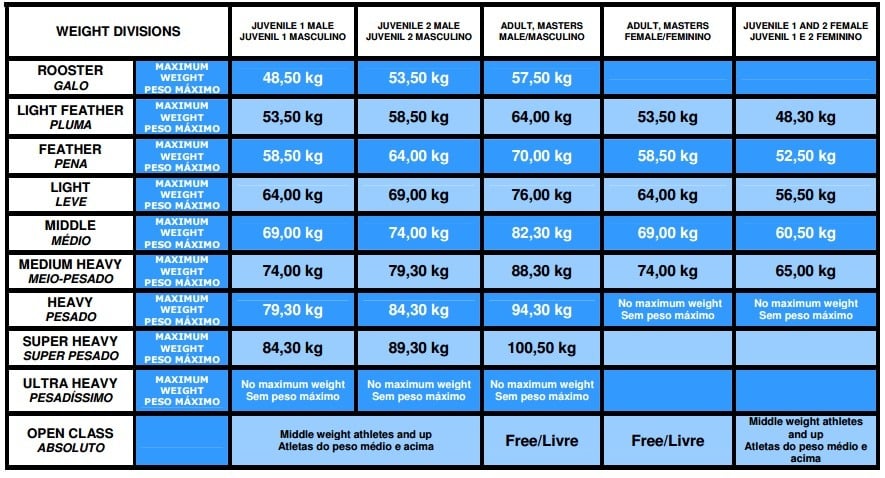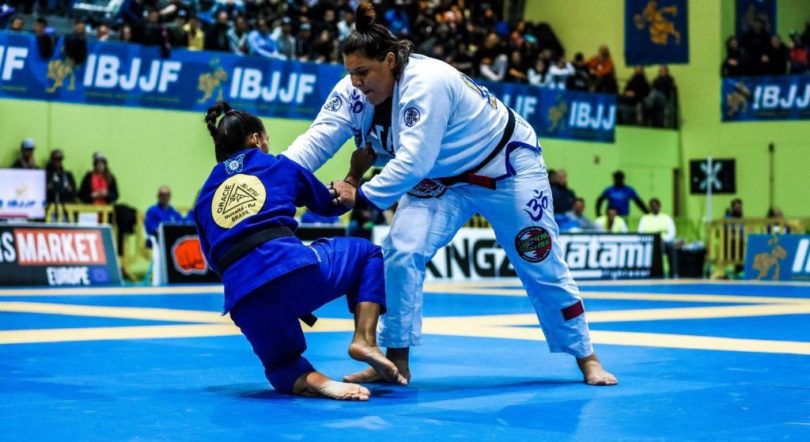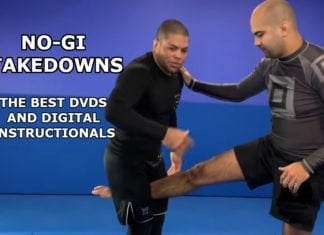
The one thing that unites all weight class-dominated sports is the horrible and debilitating practice of weight cutting. Let’s face it, nobody likes to cut weight, However, we compete in a society that forces such a practice upon us. Apart from the lucky few that have got everything in check all the time, others have to try and cut weight. Some are actually even looking o go in a different direction and add on weight. The goal is easy – getting every possible edge you can over your opponents. In Brazilian Jiu-Jitsu where most of the fight is on the bottom, being heavier than your opponent is even more important compared to other martial arts. But how do you know if you should go up or down all the various Jiu-Jitsu weight classes? Or even more importantly, what’s the best one for you?
Trying to get every possible ounce of advantage in a competition is pretty much the norm. When I talk about getting an edge, I’m talking about the fair sportsmanship ways, which do not include using PEDs or switching sexes. That said, weight cutting, or gain for that matter, are completely fairways of trying to become better. Just as you train certain techniques to perfection and you try and develop the best gas tank possible, so should you try and be the heaviest person in your weight class. However, achieving that time and time again for a competition can be really hard. So do you go up a Jiu-Jitsu class or down? Even then, how many weight classes do you go through? Let’s look at several ways that’ll help you figure out the best one for you.
BJJ Weight Divisions 101

First up let’s talk about the “official” weight classes. By official, I mean the tournaments in which most people compete and are considered to be the best in the world. Almost all of them are so far under the IBJJF banner, meaning their weight classes are pretty much the norm. In Gi Jiu-Jitsu, there are 9 male weight classes and 6 female weight classes in the adult divisions. For juveniles, weight classes are the same, but understandably wi9th a lesser range. One thing to keep in mind is that weighing in is always with the Gi, which, depending on size, can weigh anywhere from 2 to 5 lbs. That is a considerable margin to take into account.
George Lockhart is the man with the meal plan to help you cut weight. Check out his “Nutrition And Weight Management System” bundle of DVDs and E-books for the ultimate BJJ nutrition formulas!
In terms of No-Gi, weight classes are a bit different, given that here’s the IBJJF tournaments but also the ADCC. In ADCC, which is pretty much the Olympics of grappling, weight classes change at every 20 lbs (10 kg). As such, there are 5 male and 2 female weight classes. Other tournaments tend to have pretty much the same weight classes, depending on whether they are Gi or No-Gi.
How to Change Jiu-Jitsu Weight Classes
Yes, there is such a thing as the best JIu-Jitsu weight class for you. There are plenty of things you need to factor in, but several are absolutely crucial. One thing to begin with, before you even think about changing a weight class, is age. Remember that the older you get, the harder it is to both cuts or put weight on. Moreover, there’s body weight as well, plus metabolism you need to think about. People with fast metabolism might find it a lot easier to change a weight class, particularly going down. Also remember that all these factors (plus more) never work on their own but as a whole, making things complicated if you do them the wrong way.
One more thing to consider when looking for the best Jiu-Jitsu weight class for you is height. Hre’s when body weight comes into play again. If you’re on the |chubby side, you should consider going down rather than up. The reason for this is that heavier, athletically built people will usually have the advantage of reach on you. That means longer limbs to deal with and a lot more work to do.
Finally, there’s the thing young grapplers ignore, and older ones can’t stop talking about – longevity. Regardless of age or competition goals, we’re in this for the long haul. And trust me, it can be downright maddening trying to calculate every little thing you eat in every meal. Instead, it is best to find a diet that’s easy to sustain in this modern lifestyle. Even if that means you’re competing slightly over what you think is optimal for you. You’ll most likely soon find out that not having to cut weight will make up for all the weight disadvantage that you think makes such a big difference.
Moving Up Or Down A Weight Class
If you’re extremely serious as a competitor, you should already have your best Jiu-Jitsu weight class figured out by now. However, people often tend to look into changing classes, for one reason or another. In that case, you can either head up or down. Regardless of which one it is, you need to know exactly what you’re trying to accomplish, as well as understand the weight classes. In Brazilian Jiu-Jitsu, at least for adults, there are 9 Jiu-Jitsu Weight Classes you can compete in. While there are slight variations between different promotions, usually, pretty much the same rules apply.

IN terms of moving upwards among the Jiu-Jitsu weight classes, the one thing to remember is that it is hard. At least if you want to do it without illegal PEDs. Going up will require gaining muscle as opposed to fat. Since muscle is notoriously hard to pack on, a weight gain takes, even more, planning and dedication than a weight cut. Not to mention a lot more time. It is easier, though, particularly if you’re already pretty lean and do not have fat to strip off in a weight cut. However, make sure you do it right and don’t believe in any “shortcut recipes” for gaining muscle – they all fail, without exception.
In Conclusion
Unlike in MMA, there’s no real reason why someone should try and cut weight in order to drop several Jiu-Jitsu weight classes down. Instead, the sport offers plenty of weight classes for everyone to fit in without having to risk their health. However, the fact of the matter is, people will try to cut weight, and/or move up a class from time to time. IN those situations, whether it is you that’s cutting, or you’re giving advice, make sure they really need it. If so, then follow the simple rules of cutting or gaining. Only that way you get the most out of your experience and be ready to actually grapple when the time comes. Otherwise, you’re better off giving bodybuilding a try.


![Darce Choke Encyclopedia – Origins, Mechanics and Variations [2025] BJJ, choke, Brabo, BJJ Darce Choke, D'arce Choke, Darce BJJ Choke](https://bjj-world.com/wp-content/uploads/2017/11/JungPoirierLeeYahoo-218x150.jpg)









![Jiu-Jitsu For Old Guys Guard Retention Bernardo Faria DVD Review [2025] Jiu-Jitsu For Old Guys Guard Retention Bernardo Faria DVD Review](https://bjj-world.com/wp-content/uploads/2025/03/old-guys-guard-retention-bernardo-faria-dvd-review-218x150.png)
![X-Guard Trickery Kyle Sleeman DVD Review [2025] X-Guard Trickery Kyle Sleeman DVD Review](https://bjj-world.com/wp-content/uploads/2025/03/x-guard-trickery-kyle-sleeman-dvd-review-218x150.png)
![Countering with Crab Ride Anthony Budion DVD Review [2025] Countering with Crab Ride Anthony Budion DVD Review](https://bjj-world.com/wp-content/uploads/2025/03/countering-with-crab-ride-anthony-budion-dvd-review-218x150.png)
![Closet Closed Guard Craig Jones DVD Review [2025] Closet Closed Guard Craig Jones DVD Review](https://bjj-world.com/wp-content/uploads/2025/03/closet-closed-guard-craig-jones-dvd-review-218x150.png)
![Xanadu Back Takes Levi Jones-Leary DVD Review [2025] Xanadu Back Takes Levi Jones-Leary DVD Review](https://bjj-world.com/wp-content/uploads/2025/03/xanadu-back-takes-levi-jones-leary-dvd-review-218x150.png)


![The Empty Half Guard Michael Currier DVD Review [2025] The Empty Half Guard Michael Currier DVD Review](https://bjj-world.com/wp-content/uploads/2025/03/empty-half-guard-michael-currier-dvd-review-100x70.png)

![Leg Lock Strategies: Navigating Entanglements Jack Stapleton DVD Review [2024] Leg Lock Strategies: Navigating Entanglements Jack Stapleton DVD Review](https://bjj-world.com/wp-content/uploads/2024/12/navigating-entanglements-jack-stapleton-dvd-review-100x70.png)

![The Stack Pass Andre Galvao DVD Review [2025] The Stack Pass Andre Galvao DVD Review](https://bjj-world.com/wp-content/uploads/2025/01/the-stack-pass-andre-galvao-dvd-review-100x70.png)

![Power Passing Body Locks Dan Manasoiu DVD Review [2025] Power Passing Body Locks Dan Manasoiu DVD Review](https://bjj-world.com/wp-content/uploads/2025/01/power-passing-body-locks-dan-manasoiu-dvd-review-100x70.png)


![Mastering The Crucifix Alexandre Pereira DVD Review [2025] Mastering The Crucifix Alexandre Pereira DVD Review](https://bjj-world.com/wp-content/uploads/2025/01/mastering-the-crucifix-alexandre-pereira-dvd-review-100x70.png)
![Daisy Fresh WHITE BELT Wrestling Curriculum DVD Review [2024] Daisy Fresh WHITE BELT Wrestling Curriculum DVD Review](https://bjj-world.com/wp-content/uploads/2024/10/daisy-fresh-white-belt-wrestling-curriculum-review-100x70.png)

![10th Planet Leg Locks Jeremiah Vance DVD Review [2025] 10th Planet Leg Locks Jeremiah Vance DVD Review](https://bjj-world.com/wp-content/uploads/2025/01/10th-planet-leg-locks-jeremiah-vance-dvd-review-100x70.png)
![Countering Triangles And Omoplatas Adam Mazin DVD Review [2024] Countering Triangles And Omoplatas Adam Mazin DVD Review](https://bjj-world.com/wp-content/uploads/2024/10/countering-triangles-and-omoplatas-adam-mazin-dvd-REVIEW-100x70.png)
![Dynamic De La Riva Guard Otavio Sousa DVD Review [2025] Dynamic De La Riva Guard Otavio Sousa DVD Review](https://bjj-world.com/wp-content/uploads/2025/02/dynamic-de-la-riva-guard-otavio-sousa-dvd-review-100x70.png)

![Slay The Wrestle Up Guard Nick Rodriguez DVD Review [2024] Slay The Wrestle Up Guard Nick Rodriguez DVD Review](https://bjj-world.com/wp-content/uploads/2024/12/slay-the-wrestle-up-guard-nick-rodriguez-dvd-review-100x70.png)
![Forging The De La Riva Guard Giancarlo Bodoni DVD Review [2025]](https://bjj-world.com/wp-content/uploads/2025/02/de-la-riva-guard-giancarlo-bodoni-dvd-review-100x70.png)
![Higher Tripod Passing Craig Jones DVD Review [2025] Higher Tripod Passing Craig Jones DVD Review](https://bjj-world.com/wp-content/uploads/2025/02/higher-tripod-passing-craig-jones-dvd-review-100x70.png)



![Xanadu Back Takes Levi Jones-Leary DVD Review [2025] Xanadu Back Takes Levi Jones-Leary DVD Review](https://bjj-world.com/wp-content/uploads/2025/03/xanadu-back-takes-levi-jones-leary-dvd-review-100x70.png)


